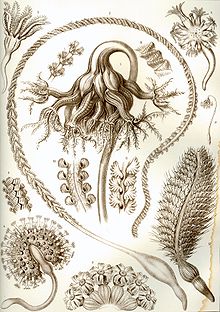This article needs additional citations for verification. (November 2007) |
| Sea pen Temporal range:
| |
|---|---|

| |
| "Pennatulida" from Ernst Haeckel's Kunstformen der Natur, 1904 | |
| Scientific classification | |
| Domain: | Eukaryota |
| Kingdom: | Animalia |
| Phylum: | Cnidaria |
| Class: | Octocorallia |
| Order: | Pennatulacea Verrill, 1865 |
| Family | |
|
see text | |
Sea pens are marine cnidarians belonging to the order Pennatulacea, which are colony-forming benthic filter feeders within the class Octocorallia (subphylum Anthozoa). There are 14 families within the order and 35 extant genera; it is estimated that of 450 described species, around 200 are valid.[1]
Sea pens have a cosmopolitan distribution, being found in tropical and temperate waters worldwide, from intertidal shallow waters to deep seas of more than 6,100 m (20,000 ft).[1] Sea pens are grouped with the octocorals together with sea whips (gorgonians), but there has been only one molecular study focusing on the phylogenetic relationships within the order Pennatulacea, which mainly treated deep-sea species, and thus information on shallow water species is still lacking.[2]
Although the group is named for its supposed resemblance to antique quill pens, only sea pen species belonging to the suborder Subselliflorae live up to the comparison. Those belonging to the much larger suborder Sessiliflorae lack feathery structures and grow in club-like or radiating forms. The latter suborder includes what are commonly known as sea pansies.
The earliest accepted sea pen fossils are known from the Cambrian-aged Burgess Shale (Thaumaptilon). Similar fossils from the Ediacaran may show the dawn of sea pens.[3] Precisely what these early fossils are, however, is not decided.[4]
- ^ a b Williams, Gary C. (2011-07-29). "The Global Diversity of Sea Pens (Cnidaria: Octocorallia: Pennatulacea)". PLoS ONE. 6 (7): e22747. Bibcode:2011PLoSO...622747W. doi:10.1371/journal.pone.0022747. PMC 3146507. PMID 21829500.
- ^ Kushida, Yuka (2019-02-05). "Molecular phylogeny and diversity of sea pens (Cnidaria: Octocorallia: Pennatulacea) with a focus on shallow water species of the northwestern Pacific Ocean". Molecular Phylogenetics and Evolution. 131: 233–244. Bibcode:2019MolPE.131..233K. doi:10.1016/j.ympev.2018.10.032. PMID 30471843.
- ^ Williams, Gary C. "Aspects of the Evolutionary Biology of Pennatulacean Octocorals". Department of Invertebrate Zoology and Geology. California Academy of Sciences. Retrieved 2023-01-27.
- ^ Antcliffe, J.B.; Brasier, M.D. (2008). "Charnia at 50: Developmental Models for Ediacaran Fronds". Palaeontology. 51 (1): 11–26. Bibcode:2008Palgy..51...11A. doi:10.1111/j.1475-4983.2007.00738.x. S2CID 83486435.